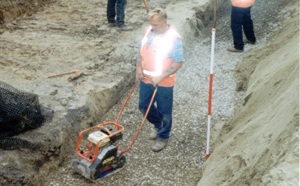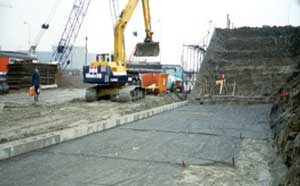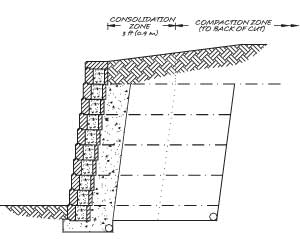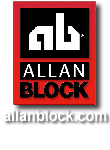Installation Specification Guidelines for Geogrid Reinforced Retaining Walls
The following specifications provide Allan Block Corporation's typical requirements and recommendations. At the engineer of record's discretion these specifications may be revised to accommodate site specific design requirements.
Section 2
Part 1: General
1.1 Scope
Work includes furnishings and installing geogrid reinforcement, wall block, and backfill to the lines and grades designated on the construction drawings and as specified herein.
1.2 Applicable Sections of Related Work
Section 1: Allan Block Modular Retaining Wall Systems
1.3 Reference Standards
See specific geogrid manufacturer’s reference standards.
Additional Standards:
- ASTM D4595 - Tensile Properties of Geotextiles by the Wide-Width Strip Method
- ASTM D5262 - Test Method for Evaluating the Unconfined Creep Behavior of Geogrids
- ASTM D6638 Grid Connection Strength (SRW-U1)
- ASTM D6916 SRW Block Shear Strength (SRW-U2)
- GRI-GG4 - Grid Long Term Allowable Design Strength (LTADS)
- ASTM D6706 - Grid Pullout of Soil
1.4 Delivery, Storage, and Handling
- Contractor shall check the geogrid upon delivery to assure that the proper material has been received.
- Geogrid shall be stored above -10 F (-23 C).
- Contractor shall prevent excessive mud, cementitious material, or other foreign materials from coming in contact with the geogrid material.
Part 2: Materials
2.1 Definitions
- Geogrid products shall be of high density polyethylene or polyester yarns encapsulated in a protective coating specifically fabricated for use as a soil reinforcement material.
- Concrete retaining wall units are as detailed on the drawings and shall be Allan Block Retaining Wall Units.
- Drainage material is free draining granular material as defined in Section 1, 2.2 Wall Rock.
- Infill soil is the soil used as fill for the reinforced soil mass.
- Foundation soil is the in-situ soil.
2.2 Products
Geogrid shall be the type as shown on the drawings having the property requirements as described within the manufacturer’s specifications.
2.3 Acceptable Manufacturers
A manufacturer's product shall be approved by the wall design engineer.
Part 3: Wall Construction
3.1 Foundation Soil Preparation

Base Compaction
- Foundation soil shall be excavated to the lines and grades as shown on the construction drawings, or as directed by the on-site soils engineer.
- Foundation soil shall be examined by the on-site soils engineer to assure that the actual foundation soil strength meets or exceeds assumed design strength.
- Over-excavated areas shall be filled with compacted backfill material approved by on-site soils engineer.
- Contractor shall verify locations of existing structures and utilities prior to excavation. Contractor shall ensure all surrounding structures are protected from the effects of wall excavation.
3.2 Wall Construction
Wall construction shall be as specified under Section 1, Part 3, Wall Construction.
3.3 Geogrid Installation

Grid Installation
- Install Allan Block wall to designated height of first geogrid layer. Backfill and compact the wall rock and infill soil in layers not to exceed 8 in. (200 mm) lifts behind wall to depth equal to designed grid length before grid is installed.
- Cut geogrid to designed embedment length and place on top of the Allan Block units to back edge of the raised front lip, for AB, AB Aztec, AB Metropolitan or AB Europa Collection, or the middle of the facing unit for the AB Fieldstone Collection. Extend away from wall approximately 3% above horizontal on compacted backfill.
- Lay geogrid at the proper elevation and orientations shown on the construction drawings or as directed by the wall design engineer.
- Correct orientation of the geogrid shall be verified by the contractor and on-site soils engineer. Strength direction is typically perpendicular to wall face.
- Follow manufacturer’s guidelines for overlap requirements. In curves and corners, layout shall be as specified in in Design Detail: Using Grid with Corners and Curves, in the AB Spec Book.
- Place next course of Allan Block on top of grid and fill block cores with wall rock to lock in place. Remove slack and folds in grid and stake to hold in place.
- Adjacent sheets of geogrid shall be butted against each other at the wall face to achieve 100 percent coverage.
- Geogrid lengths shall be continuous. Splicing parallel to the wall face is not allowed.
3.4 Fill Placement

Backfilling with Geogrid

Consolidation Zone - Reinforced Zone

Compaction and Geogrid
- Infill soil shall be placed in lifts and compacted as specified under Section 1, Part 3.4, Unit Installation.
- Infill soil shall be placed, spread and compacted in such a manner that minimizes the development of slack or movement of the geogrid.
- Only hand-operated compaction equipment shall be allowed within 3 ft (0.9 m) behind the wall. This area shall be defined as the consolidation zone. Compaction in this zone shall begin by running the plate compactor directly on the block and then compacting in parallel paths from the wall face back, until the entire consolidation zone has been compacted. A minimum of two passes of the plate compactor are required with maximum lifts of 8 in. (200 mm). Section 1, Part 3.4 E, Page 3.
- When fill is placed and compaction cannot be defined in terms of Standard Proctor Density, then compaction shall be performed using ordinary compaction process and compacted so that no deformation is observed from the compaction equipment or to the satisfaction of the engineer of record or the site soils engineer.
- Tracked construction equipment shall not be operated directly on the geogrid. A minimum fill thickness of 6 in. (150 mm) is required prior to operation of tracked vehicles over the geogrid. Turning of tracked vehicles should be kept to a minimum to prevent tracks from displacing the fill and damaging the geogrid.
- Rubber-tired equipment may pass over the geogrid reinforcement at slow speeds, less than 10 mph (16 Km/h). Sudden braking and sharp turning shall be avoided.
- The infill soil shall be compacted to achieve 95% Standard Proctor (ASTM D698). Soil tests of the infill soil shall be submitted to the on-site soils engineer for review and approval prior to the placement of any material. The contractor is responsible for achieving the specified compaction requirements. The on-site soils engineer may direct the contractor to remove, correct or amend any soil found not in compliance with these written specifications.
- An independent testing firm should be hired by the owner to provide services.
- Independent firm to keep inspection log and provide written reports at predetermined intervals to the owner.
- Testing frequency should be set to establish a proper compaction protocol to consistently achieve the minimum compaction requirements set by the design requirements. If full time inspection and testing at 8 inch (20 cm) lifts is not provided, then the following testing frequency should be followed:
- One test for every 8 inches (20 cm) of vertical fill placed and compacted, for every 25 lineal feet (7.6 m) of retaining wall length, starting on the first course of block.
- Vary compaction test locations to cover the entire area of reinforced zone; including the area compacted by the hand-operated compaction equipment.
- Once protocol is deemed acceptable, testing can be conducted randomly at locations and frequencies determined by the on-site soils engineer.
- Slopes above the wall must be compacted and checked in a similar manner.
3.5 Special Considerations
- Geogrid can be interrupted by periodic penetration of a column, pier or footing structure.
- Fence post or railings should be positioned 3 ft. (0.9 m) behind the top course to allow proper overturning design. Fence posts within 3 ft. (0.9 m) need to consider the local overturning forces applied to the wall facing.
- If site conditions will not allow geogrid embedment length, consider the following alternatives:
- Masonry Reinforced Walls
- Increased Wall Batter
- Double Allan Block Wall
- No-Fines Concrete
- Soil Nailing
- Earth Anchors
- Rock Bolts
- Allan Block walls will accept vertical and horizontal reinforcing with rebar and grout. A grouted connection could be used with geogrid reinforcement if needed.
- For masonry reinforced walls, block modification may be necessary to allow for rebar placement. Masonry wall and parapet design and construction requires site specific analysis for every wall case.
- Allan Block may be used in a wide variety of water applications as indicated in Section 3, Part 1.8.
Consult the Allan Block Engineering Department for additional details at engineering@allanblock.com or (800)899-5309. Specifications are subject to change without notice.


